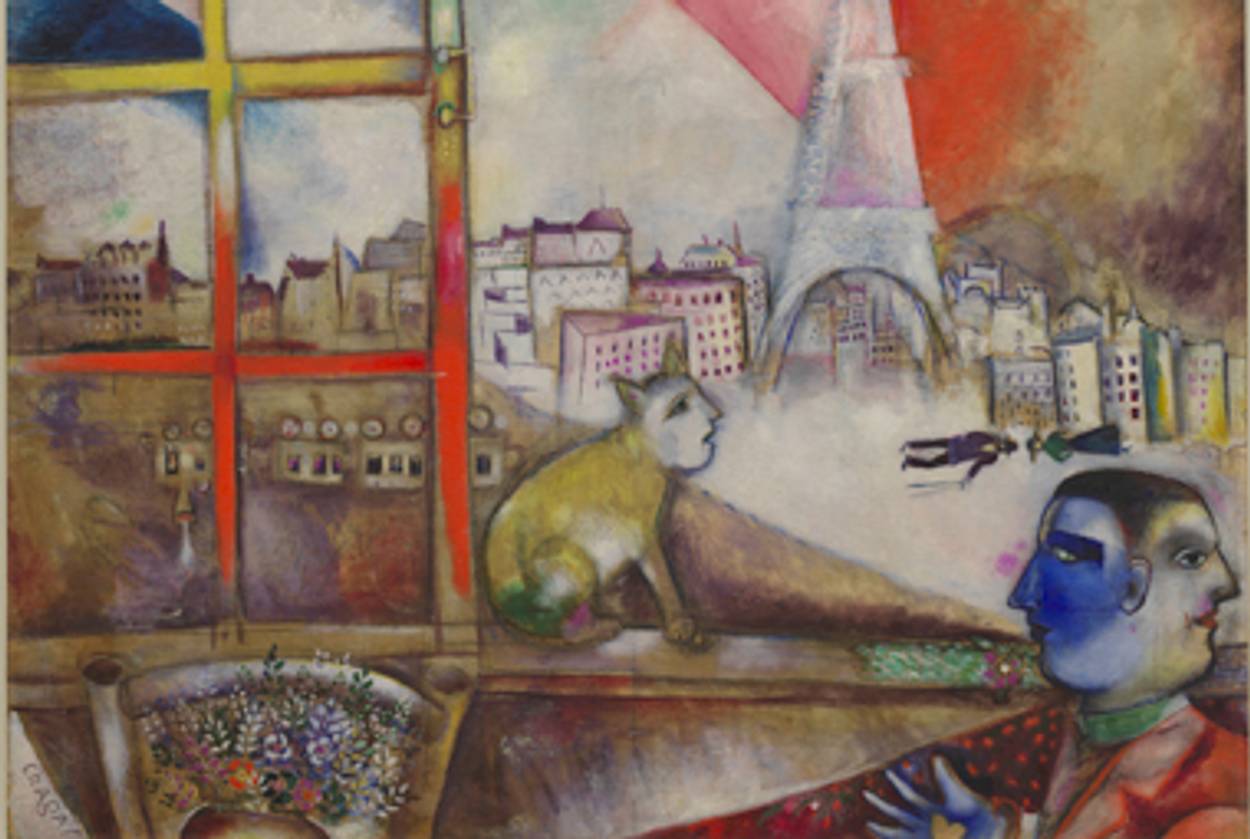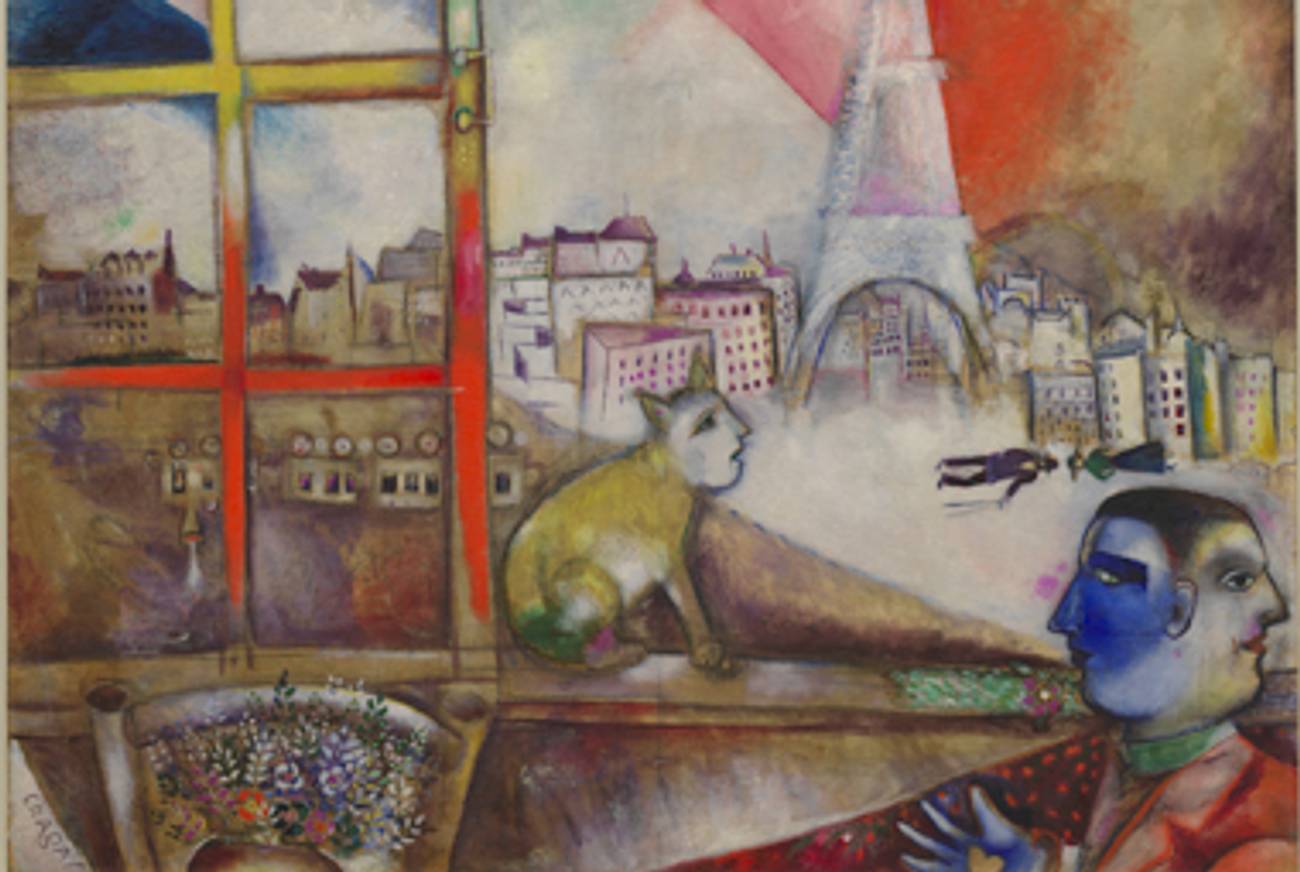Hasidic Cubism
A new exhibition highlights how Marc Chagall was both a part of and apart from the avant-garde movements that defined the Parisian art scene in the years before and after World War I




I’m not sure that Chagall could actually see the Eiffel Tower from his studio when he painted his gorgeous 1913 fantasy Paris Through the Window (he could certainly catch the stench of the nearby slaughterhouses), but that symbol of “look at me” engineering certainly divides his canvas usefully enough. To the left of it, there’s an upside down train heading back to Vitebsk; to the right, there’s a parachutist floating down, airy and free, in much the way Chagall apparently felt when he first descended on the city. Most of us know how great it is to arrive in Paris. For Chagall, a Belorussian Jew from Vitebsk, who, on account of his religious affiliation, had been required a special permit to live in St. Petersburg, it was something close to heaven.
And yet, Chagall couldn’t let go of the past, and this is what distinguishes him from his Jewish confreres who also set up shop in Montparnasse and Montmartre to paint, draw, sculpt, and party their way through the stupendous Bohemian revels that Paris hosted in the years leading up to World War I, and then again in the roaring Twenties.
The Philadelphia Museum of Art has set out to take a look at the work of a group of émigré artists that count in their number a large group of Jewish painters and sculptors— including Amedeo Modigilani, Chaim Soutine, Jules Pascin, Jacques Lipschitz, Moise Kisling, and Chana Orloff—to see what they were thinking about while they looked through their French windows at more or less the same time that Chagall was in town. It becomes clear very fast that, with the exception of Chagall himself, and despite the carnival atmosphere, what was on their collective mind wasn’t Purim.
True, Modigliani went around town declaring “I’m Jewish” as a calling card and picking fights with Parisian anti-Semites, while Soutine’s expressionism was locally regarded as typical over-the top-Jewish drama queen venting, but you will search long and hard in their work to discover more than a smattering of Jewish subject matter. The anagrammatic disguise in Jules Pascin’s name—he began life in Bulgaria as Julius Pincas—pretty much tells the whole story of how the Jews went native in Paris. Modigliani started off by exhibiting his painting “The Jewess” in the Salon des Indépendents in 1919 but quickly moved on to languorous nudes and alluring long-necked women. Soutine’s squigglevision landscapes and Pascin’s borderline-porno little girls didn’t have much of a Jewish story to tell either.
Chagall, on the other hand, couldn’t stop looking both ways at once, backward and forward, East and West, over his shoulder at the observantly Jewish world he’d left behind and straight ahead to the secular one he inhabited for the remainder of his life. Hence, the Janus-like head in the bottom right-hand corner of Paris Through the Window.
By all accounts, Chagall wasn’t a Paris party animal. The others would sometimes try to coax him away from his work by chucking stones at his studio windows, but with little success. Cubism certainly got to Chagall (it got to everybody), as did the swirling disks of Robert Delaunay’s Orphism. In fact, what Chagall mainly saw when he looked out of his window was a world with perspective shattered only to be reconstructed in planes and spheres. Chagall, it has been said, was the first (and last) painter to fuse Cubism with Hasidism. He brilliantly harnessed his Yiddish past to modernist techniques and in this way sneaked Yiddish culture into 20th-century painting. Because the vibrant visual expression of his paintings carried the stamp of the modern and not the stigma of a dying language, hardly anyone, with the exception of the odd French anti-Semite, noticed what was happening.
In short, Chagall was a secular Jew who couldn’t get Jews off his mind, in either his life or his art, and in this sense perhaps he resembles no other 20th-century artist so much as Philip Roth. Both managed to experiment with technique (think of The Counterlife) and engage the widest possible audience while obsessively ruminating on Jewish life.
In 1914, Chagall left Paris and spent the war years in Russia. By the time he got back in 1922, he was largely done with Cubism, but Hasidim lingered in his imagination and kept cropping up for the rest of his life.
The Philadelphia show, somewhat hamstrung by its reliance on the museum’s own collection, doesn’t linger in Paris but accompanies Chagall through his wartime and revolutionary years in Russia. A spectacular Chagall from 1915, The Poet Reclining, painted after his honeymoon,is reproduced in the catalog and promised in the publicity material as being on loan from London’s Tate Gallery, but, unless I missed it (and I checked through the exhibition twice), it isn’t there.
However, we do see intimate details of Russian life on the cusp or in the throes of great changes: The Smolensk Newspaper (1914), with its headline declaration of war; a Wounded Soldier (1914); and, perhaps the most striking painting in the exhibition, Oh God (1919), in which the neck of a man in a white suit holds an inverted head searching a dark sky. To the right of the figure there are a few Vitebsk homes, the blue cupola of an Orthodox church, and the Russian letters for “Oh God.” Chagall executed this uncharacteristically gloomy painting as the Suprematist master Kazimir Malevich was trying to oust him from his position as head of the Vitebsk art school. Maybe it was revolutionary zeal that led Chagall to these bold Russian strokes, but what the painting most powerfully conveys is “Oy vey.”
While Chagall was painting his anthropomorphic animals transported from the folk world of Vitebsk (see: The Watering Trough, 1925), old Jews, and a gift exchange on Purim (Purim 1916-17), his peers were more absorbed with the secular Paris zeitgeist. The Philadelphia show has some delightful examples including three sculptures—Chana Orloff’s neo-Futurist The Dancers (1923), Jacques Lipchitz’s Sailor With Guitar (1914),and Modigliani’s Brancusi-influenced Head of a Woman (1911)—that are all movement and beauty.
Sometimes Jews just like to party like it’s Fleet week.
The exhibition Paris Through the Window: Marc Chagall and His Circle will be at the Philadelphia Museum of Art through July 10.
Jonathan Wilsonis the director of the Center for the Humanities at Tufts University. His books include the novel A Palestine Affair, the story collection An Ambulance Is On the Way, and, from Nextbook Press, the biography Marc Chagall.
Jonathan Wilson, the director of the Center for the Humanities at Tufts University, is the author of, among other books, the Nextbook Press biography of Marc Chagall.
Jonathan Wilson is the author of eight books including the novel A Palestine Affair and a biography, Marc Chagall. He recently completed a novel, Hotel Cinema, about the unsolved murder of Chaim Arlosoroff.